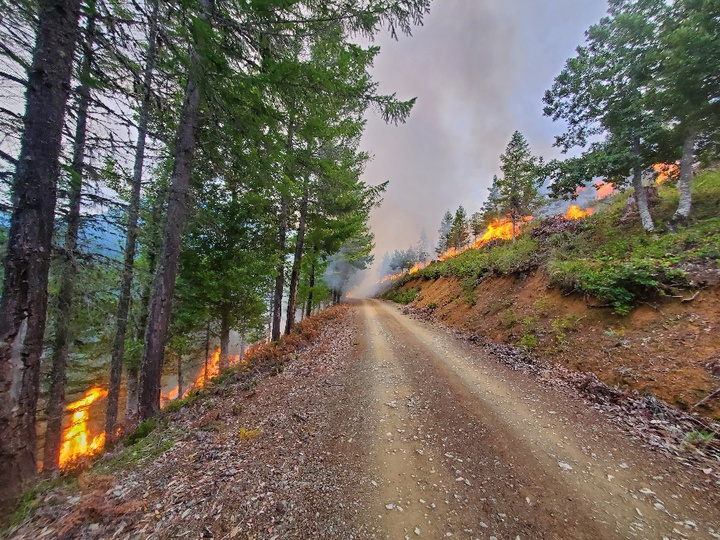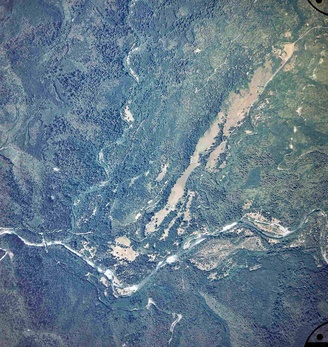Jessica Cejnar Andrews / Thursday, Feb. 24, 2022 @ 12:47 p.m. / Community, Fire, Tribal Affairs
Smith River NRA, Community Partners Receive $2 Million Federal Grant for Wildfire Preparedness Work Near Big Flat

This prescription burning on the Smith River National Recreation Area is similar to what Big Flat residents will see this spring and summer. Photo courtesy of the U.S. Forest Service
A project to re-treat a network of fuel breaks on the ridges and roads around Big Flat is expected to begin as early as this spring, National Forest Service officials say.
The Big Flat Community Protection Project will cover more than 11,000 acres within the Smith River watershed. The project will be conducted in partnership with the Six Rivers National Forest, the Natural Resource Conservation Service and the Smith River Collaborative.
The Six Rivers National Forest will use $838,000 in federal grant dollars for fuels reduction on federal lands within the Smith River National Recreation Area, according to Sheila Balent, the Smith River NRA’s fuels planner.
The Natural Resource Conservation Service will use approximately $1.36 million for similar work on private land near Big Flat, Balent told the Wild Rivers Outpost on Thursday.
“On the federal lands, fuel breaks were created on the main ridges and road systems around the community of Big Flat in 2009-2012,” she said. “This project will retreat or maintain those strategically placed fuel breaks by thinning small diameter trees and brush, piling the debris and then burning the materials when conditions are right.”
Those grant dollars, a total of about $2.2 million was awarded to the NRCS, the Smith River Collaborative and the Smith River NRA through the FY22 Joint Chiefs’ Landscape Restoration Partnership, which comes “straight from the Biden-Harris administration,” according to a Six Rivers National Forest news release.
According to Balent, the project on the federal side of things will consist of 600 acres of reestablishing fuel breaks. Those federal lands are currently dominated by dense Douglas fir and tan oak.
NRCS and the Smith River Collaborative will focus on fuel breaks along private land and access roads for the community.

Aerial photo of the Big Flat Community Protection Project. Photo courtesy of the U.S. Forest Service
Created in 2016, the Smith River Collaborative includes Del Norte County elected officials, environmental groups including the Smith River Alliance, Friends of Del Norte and EPIC, the Elk Valley Rancheria and the Tolowa Dee-ni’ Nation, the Del Norte Fire Safe Council, the American Forest Resource Council and the Six Rivers National Forest.
The Big Flat community, located on Tolowa Dee-ni’ Nation ancestral lands, sits alongside the South Fork Smith River about 16 miles from U.S. 199. It’s off the grid, has no official fire department and limited water availability, according to the Six Rivers National Forest’s grant application. There’s only one primary road in and out and response times for CalFire, Forest Service and local fire agencies is “long and largely inadequate to protect public safety.”
Big Flat also has a long history with wildfires ranging from the Haines fire back in 1960 to the Coon Fire in 2015. In 2017, the 78,698 acre Eclipse Fire “put the entire community on alert for evacuation,” Six Rivers’ grant application states.
“One of the highest fire threat areas in the county sits northeast of Big Flat, in the headwaters area of Jones and Hurdygurdy creeks,” the application states, citing CalFire’s 2020 Del Norte County Community Wildfire Protection Plan.
The Big Flat Community Project also includes funding for the Smith River Alliance to conduct outreach and education. According to the organization’s co-executive director, Grant Werschkull, that education and outreach will focus on the steps individual homeowners can take to make their properties more resilient.
“Home hardening is the phrase that’s used,” he told the Outpost. “What they find in these really extreme catastrophic fires is homes are better prepared in terms of the vegetation around them, how they’re vented, how they’re screened, where do they pile their wood — all these things are things you can do to give you a better chance of keeping your house.”
CLICK TO MANAGE